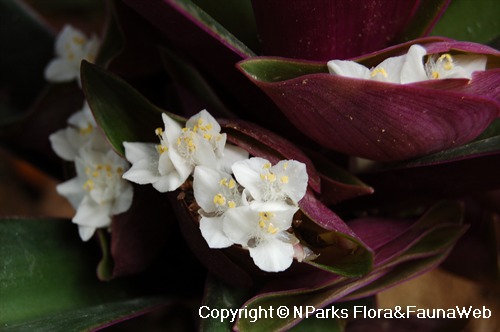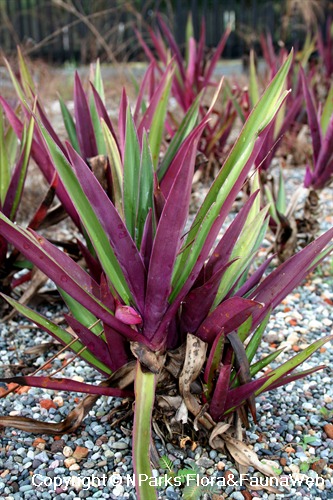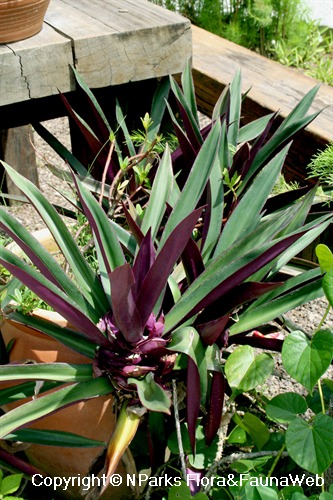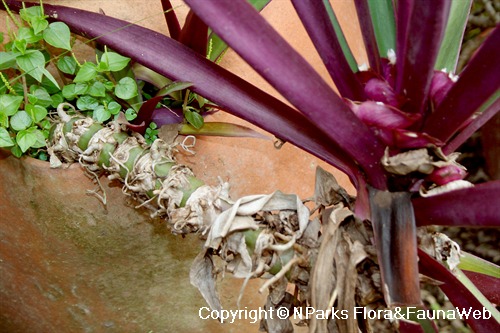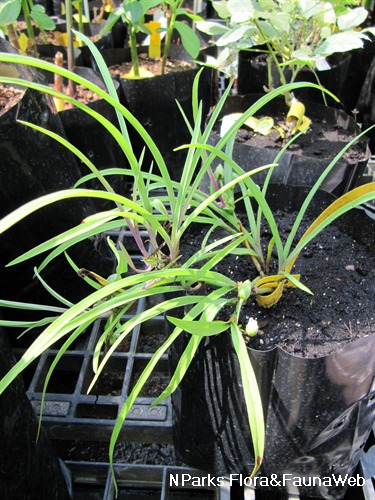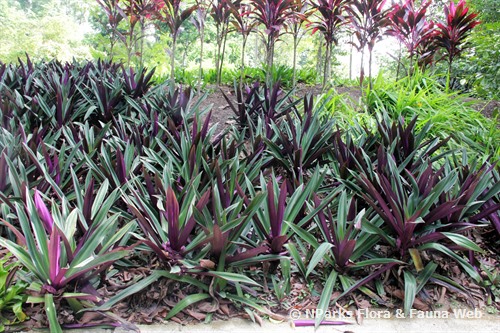
Back
Tradescantia spathacea Sw.
| Family Name: | Commelinaceae |
| Synonyms: | Rhoeo discolor, Tradescantia discolor, Rhoeo spathacea |
| Common Name: | Boat Lily, Oyster Plant, Cradle Lily, Moses-in-the-Cradle, Moses in His Cradle, Moses on a Raft, Moses in the Bulrushes, Men in a Boat, 蚌花, 紫背万年青, 荷包花 |
Name
Classifications and Characteristics
| Plant Division | Angiosperms (Flowering Seed Plants) (Monocotyledon) |
|---|---|
| Plant Growth Form | Herbaceous Plant, Creeper |
| Lifespan (in Singapore) | Perennial |
| Mode of Nutrition | Autotrophic |
| Maximum Height | 0.3 m to 0.5 m |
Biogeography
| Native Distribution | West Indies, Southern Mexico, Guatemala |
|---|---|
| Preferred Climate Zone | Tropical |
Description and Ethnobotany
| Growth Form | Semi-epiphytic herbaceous plant with underground rhizomes and clumping rosette form. |
|---|---|
| Foliage | Leaves long and sword-shaped, dark teal green on top, vivid purple on underside, waxy and fleshy. |
| Stems | Trunk-like, short and stout, nearly hidden by overlapping leaves. |
| Flowers | Flowers small, white, nestled in purple boat-shaped bracts, produced whole year round at leaf axils. |
| Fruit | Fruits are capsules with 2 seeds. |
| Cultivation | Provide good drainage to prevent root rot. Propagate by stem-cuttings, seeds or division. Watery sap may result in skin stinging and itching in sensitive individuals or animals. Plant should not be eaten raw, as sap can cause burning pain in mouth and throat. |
| Etymology | Genus epithet 'Tradescantia' named after John Tradescant, gardener for King Charles I of England. Species epithet 'spathacea' means 'with a spathe', describing the spathe-like bract holding the flowers. |
| Ethnobotanical Uses | Edible Plant Parts : Edible Leaves Food (Herb or Spice) Medicinal: Scientific Evidence of Medicinal Properties In pre-clinical trials, Boat Lily showed anti-cancer (Rosales-Reyes et al., 2008), anti-diabetic (Jesetti et al., 2020) and anti-inflammation (Pérez et al., 1996) in animals. Traditional Medicinal Uses Research supports the traditional use of Boat Lily to treat cough, bronchitis and sprains. Other traditional uses include treating fever, amenorrhea, headache and rheumatism. It is important to note that some therapeutic effects from traditional medicinal uses of plants are not currently supported or verified by scientific research. Caution: Astringent sap may cause stinging and itching in susceptible individuals and animals. Do not eat the plant raw, as sap may cause mouth and throat pain.
|
Landscaping Features
| Desirable Plant Features | Ornamental Foliage |
|---|---|
| Landscape Uses | Container Planting, Suitable for Rooftops, Interiorscape/ Indoor Plant, General, Flowerbed / Border |
| Thematic Landscaping | Economic Garden |
| Usage Hazard - Cons | Irritant - Sap |
| Usage Hazard - Cons Remarks | Astringent sap may cause stinging and itching in susceptible individuals and animals. Do not eat plant raw, as sap can cause pain in mouth and throat. |
Plant Care and Propagation
| Light Preference | Semi-Shade, Full Sun |
|---|---|
| Water Preference | Moderate Water |
| Plant Growth Rate | Fast |
| Rootzone Tolerance | Easy to Grow, Drought Tolerant, Fertile Loamy Soils, Well-Drained Soils, Poor Infertile Soils, Shallow Media |
| Maintenance Requirements | Moderate |
| Potential Problems | Prone to root rot, if soil is not well-drained. |
| Propagation Method | Seed, Stem Cutting, Sucker, Division |
| Propagation Method Remarks | Rhizomes |
Foliar
| Foliage Retention | Evergreen |
|---|---|
| Mature Foliage Colour(s) | Green, Purple |
| Mature Foliage Texture(s) | Smooth, Thick |
| Foliar Type | Simple / Unifoliate |
| Foliar Arrangement Along Stem | Whorled |
| Foliar Shape(s) | Non-Palm Foliage (Linear) |
| Foliar Venation | Parallel |
| Foliar Margin | Entire |
| Foliar Apex - Tip | Acute |
| Foliar Base | Truncate / Square |
| Typical Foliar Area | Mesophyll ( 45cm2 - 182.25 cm2 ) |
| Leaf Area Index (LAI) for Green Plot Ratio | 3.5 (Shrub & Groundcover - Monocot) |
Non - Foliar and Storage
| Stem Type & Modification | Herbaceous |
|---|---|
| Root Type | Underground (Fibrous Root) |
| Specialised Storage Organ(s) | Underground (Rhizome), Aboveground |
Floral (Angiosperm)
| Flower & Plant Sexuality | Bisexual Flowers |
| Flower Colour(s) | White |
|---|---|
| Flowering Habit | Polycarpic |
Fruit, Seed and Spore
| Fruit Classification | Simple Fruit |
|---|---|
| Fruit Type | Dehiscent Dry Fruit , Capsule |
Image Repository
Others
| Master ID | 1231 |
|---|---|
| Species ID | 2524 |
| Flora Disclaimer | The information in this website has been compiled from reliable sources, such as reference works on medicinal plants. It is not a substitute for medical advice or treatment and NParks does not purport to provide any medical advice. Readers should always consult his/her physician before using or consuming a plant for medicinal purposes. |

